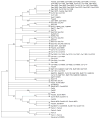A genetic comparison of two alleged subspecies of Philippine cynomolgus macaques
- PMID: 24979664
- PMCID: PMC4212691
- DOI: 10.1002/ajpa.22564
A genetic comparison of two alleged subspecies of Philippine cynomolgus macaques
Abstract
Two subspecies of cynomolgus macaques (Macaca fascicularis) are alleged to co-exist in the Philippines, M. f. philippensis in the north and M. f. fascicularis in the south. However, genetic differences between the cynomolgus macaques in the two regions have never been studied to document the propriety of their subspecies status. We genotyped samples of cynomolgus macaques from Batangas in southwestern Luzon and Zamboanga in southwestern Mindanao for 15 short tandem repeat (STR) loci and sequenced an 835 bp fragment of the mtDNA of these animals. The STR genotypes were compared with those of cynomolgus macaques from southern Sumatra, Singapore, Mauritius and Cambodia, and the mtDNA sequences of both Philippine populations were compared with those of cynomolgus macaques from southern Sumatra, Indonesia and Sarawak, Malaysia. We conducted STRUCTURE and PCA analyses based on the STRs and constructed a median joining network based on the mtDNA sequences. The Philippine population from Batangas exhibited much less genetic diversity and greater genetic divergence from all other populations, including the Philippine population from Zamboanga. Sequences from both Batangas and Zamboanga were most closely related to two different mtDNA haplotypes from Sarawak from which they are apparently derived. Those from Zamboanga were more recently derived than those from Batangas, consistent with their later arrival in the Philippines. However, clustering analyses do not support a sufficient genetic distinction of cynomolgus macaques from Batangas from other regional populations assigned to subspecies M. f. fascicularis to warrant the subspecies distinction M. f. philippensis.
Keywords: Macaca fascicularis; mitochondrial DNA; short tandem repeat (STR); subspecies.
© 2014 Wiley Periodicals, Inc.
Figures





References
-
- Abegg C, Thierry B. Macaca evolution and dispersal in insular south-east Asia. Biol J Linn Soc. 2002;75:555–576.
-
- Arnason U, Gullberg A, Burquete AS, Janke A. Molecular estimates of primate divergences and new hypotheses for primate dispersal and the origin of modern humans. Hereditas. 2000;133:217–228. - PubMed
-
- Bandelt H-J, Forster P, Roehl A. Median-joining networks for inferring intraspecific phylogenies. Mol Biol Evol. 1999;16:37–48. - PubMed
-
- Barker G, Barton H, Beavitt P, Bird M, Daly P, Doherty C, Gilbertson D, Hunt C, Krigbaum J, Lewis H, Manser J, McLaren S, Paz V, Piper P, Pyatt B, Rabett R, Reynolds T, Rose J, Rushworth G, Stephens M. Prehistoric foragers and farmers in southeast Asia: renewed investigations at Niah Cave, Sarawak. Proc Prehist Soc. 2002;68:147–164.
-
- Delson E. Fossil macaques, phyletic relationships and a scenario of deployment. In: Lindburg DG, editor. The macaques. Studies in ecology, behavior and evolution. New York: van Nostrand Rheinhold; 1980. pp. 10–30.
Publication types
MeSH terms
Substances
Grants and funding
LinkOut - more resources
Full Text Sources
Other Literature Sources

